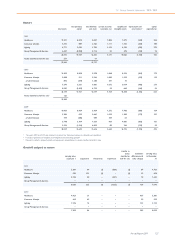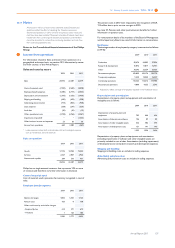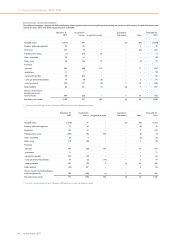Philips 2011 Annual Report Download - page 134
Download and view the complete annual report
Please find page 134 of the 2011 Philips annual report below. You can navigate through the pages in the report by either clicking on the pages listed below, or by using the keyword search tool below to find specific information within the annual report.
12 Group financial statements 12.10 - 12.10
134 Annual Report 2011
• The proceeds received on the initial transfer and the amount of any
residual value or repurchase price, measured on a present value
basis, is equal to substantially all (normally at least 90%) of the fair
value of the asset at the sale date;
• Insurance risk is borne by the customer; however, if the customer
bears the insurance risk but the Company bears the remaining risks,
then risks and rewards have not been transferred to the customer;
and
• The repurchase price is equal to the market value at the time of the
buy-back.
In case of loss under a sales agreement, the loss is recognized
immediately.
Shipping and handling billed to customers is recognized as revenues.
Expenses incurred for shipping and handling of internal movements of
goods are recorded as cost of sales. Shipping and handling related to
sales to third parties are recorded as selling expenses. Service revenue
related to repair and maintenance activities for goods sold is recognized
ratably over the service period or as services are rendered.
A provision for product warranty is made at the time of revenue
recognition and reflects the estimated costs of replacement and free-
of-charge services that will be incurred by the Company with respect
to the products. For certain products, the customer has the option to
purchase an extension of the warranty, which is subsequently billed to
the customer. Revenue recognition occurs on a straight-line basis over
the contract period.
Revenue from services is recognized when the Company can reliably
measure the amount of revenue and the associated cost related to the
stage of completion of a contract or transaction, and the recovery of
the consideration is considered probable.
Royalty income, which is generally earned based upon a percentage of
sales or a fixed amount per product sold, is recognized on an accrual
basis.
Grants from the government are recognized at their fair value where
there is a reasonable assurance that the grant will be received and the
Company will comply with all attached conditions. Government grants
relating to costs are deferred and recognized in the Statement of
income over the period necessary to match them with the costs that
they are intended to compensate.
Financial income and expenses
Financial income comprises interest income on funds invested
(including available-for-sale financial assets), dividend income, net gains
on the disposal of available-for-sale financial assets, net fair value gains
on financial assets at fair value through profit or loss, net gains on the
remeasurement to fair value of any pre-existing available-for-sale
interest in an acquiree, and net gains on hedging instruments that are
recognized in the Statement of income. Interest income is recognized
on accrual basis in the Statement of income, using the effective interest
method. Dividend income is recognized in the Statement of income on
the date that the Company’s right to receive payment is established,
which in the case of quoted securities is normally the ex-dividend date.
Financial expenses comprise interest expense on borrowings,
unwinding of the discount on provisions and contingent consideration,
losses on disposal of available-for-sale financial assets, net fair value
losses on financial assets at fair value through profit or loss, impairment
losses recognized on financial assets (other than trade receivables), and
net losses on hedging instruments that are recognized in the Statement
of income.
Borrowing costs that are not directly-attributable to the acquisition,
construction or production of a qualifying asset are recognized in the
Statement of income using the effective interest method.
Foreign currency gains and losses are reported on a net basis as either
financial income or financial cost depending on whether foreign
currency movements are in a net gain or net loss position.
Income tax
Income tax comprises current and deferred tax. Income tax is
recognized in the Statement of income except to the extent that it
relates to items recognized directly within equity or in other
comprehensive income. Current tax is the expected tax payable on the
taxable income for the year, using tax rates enacted or substantially-
enacted at the reporting date, and any adjustment to tax payable in
respect of previous years.
Deferred tax assets and liabilities are recognized, using the balance
sheet method, for the expected tax consequences of temporary
differences between the carrying amounts of assets and liabilities and
the amounts used for taxation purposes. Deferred tax is not recognized
for the following temporary differences: the initial recognition of
goodwill, the initial recognition of assets and liabilities in a transaction
that is not a business combination and that affects neither accounting
nor taxable profit, and differences relating to investments in subsidiaries
to the extent that they probably will not reverse in the foreseeable
future. Deferred tax is measured at the tax rates that are expected to
be applied to temporary differences when they reverse, based on the
laws that have been enacted or substantially-enacted by the reporting
date. Deferred tax assets and liabilities are offset if there is a legally-
enforceable right to offset current tax liabilities and assets, and they
relate to income taxes levied by the same tax authority on the same
taxable entity, or on different tax entities, but they intend to settle
current tax liabilities and assets on a net basis or their tax assets and
liabilities will be realized simultaneously.
A deferred tax asset is recognized for unused tax losses, tax credits and
deductible temporary differences, to the extent that it is probable that
future taxable profits will be available against which they can be utilized.
The ultimate realization of deferred tax assets is dependent upon the
generation of future taxable income in the countries where the
deferred tax assets originated and during the periods when the deferred
tax assets become deductible. Management considers the scheduled
reversal of deferred tax liabilities, projected future taxable income, and
tax planning strategies in making this assessment.
Deferred tax liabilities for withholding taxes are recognized for
subsidiaries in situations where the income is to be paid out as dividend
in the foreseeable future, and for undistributed earnings of
unconsolidated companies to the extent that these withholding taxes
are not expected to be refundable or deductible. Changes in tax rates
are reflected in the period when the change has been enacted or
substantially-enacted by the reporting date.
Discontinued operations and non-current assets held for sale
Non-current assets (disposal groups comprising assets and liabilities)
that are expected to be recovered primarily through sale rather than
through continuing use are classified as held for sale.
A discontinued operation is a component of an entity that either has
been disposed of, or that is classified as held for sale, and (a) represents
a separate major line of business or geographical area of operations;
and (b) is a part of a single coordinated plan to dispose of a separate
major line of business or geographical area of operations; or (c) is a
subsidiary acquired exclusively with a view to resale. Only those costs
that are clearly identifiable as costs of the components that is being
disposed of and that will not be recognized on an ongoing basis by the
Company, are included under discontinued operations.
Non-current assets held for sale and discontinued operations are
carried at the lower of carrying amount or fair value less costs to sell.
Any gain or loss from disposal of a business, together with the results
of these operations until the date of disposal, is reported separately as
discontinued operations. The financial information of discontinued
operations is excluded from the respective captions in the
Consolidated statements of income, Consolidated statements of cash
flow and related notes for all years presented. A discontinued operation
is a component of the Company, which comprises operations and cash
flows that can be distinguished clearly, both operationally and for
financial reporting purposes, from the rest of the Company. A
component that previously was held for use will have been one or more
cash-generating units. Generally, the disposal of a business that
previously was part of a single cash-generating unit does not qualify as
a component of an entity and therefore shall not be classified as a
discontinued operation if disposed of.
Comparatives in the balance sheet are not re-presented when a non-
current asset or disposal group is classified as held for sale.
Comparatives are restated for presentation of discontinued operations
in the Statement of cash flow and Statement of income.
Upon classification of a disposal group as held for sale the Company
may agree with the buyer to retain certain assets and liabilities (e.g.
accounts receivable), in which case such items are not presented as part
























